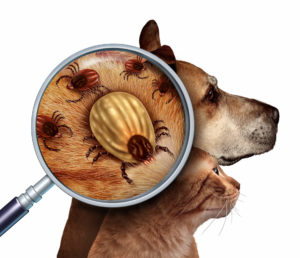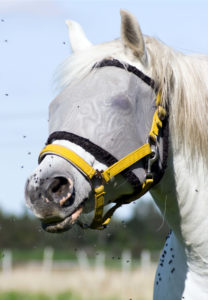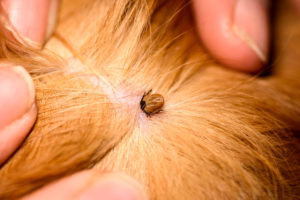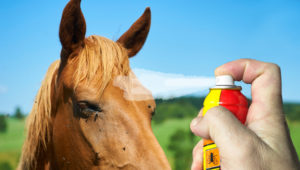Updated August 17, 2022.
Ticks are still alive in many areas and are looking for a last meal before winter is in full swing!
Fly sprays toxicity is real.
 With chemicals in pet products advancing, our dogs and horses are not equipped to detoxify against the shampoos, collars, spot-on products, and fly sprays that we are introducing into their systems.
With chemicals in pet products advancing, our dogs and horses are not equipped to detoxify against the shampoos, collars, spot-on products, and fly sprays that we are introducing into their systems.
Companies claim the safety of their products, but as the testing data to allow these products to go on the market is short-term, they aren’t incentivized to follow the long-term effects.
With no surprise, studies find that many commercially produced tick and flea products are hurting more than the intended pests.
EPA releases studies about toxicity but isn’t changing its regulations.

Until the U.S. Environmental Protection Agency stops allowing these harmful products to land on the shelves of every pet aisle, it is important to educate yourself on the risks of the dangerous chemicals in our animal repellents. Most flea and tick products, such as collars and fly sprays, are actually registered as pesticides by the EPA. Many issues have been reported as a result of pet poisonings.
Almost all of the fly repellents currently on the market that are formulated for horses are based on a chemical called pyrethrin. Pyrethrum is an extract of chrysanthemum flowers. While the flowers are natural and contains two naturally occurring insecticides (pyrethrin I and pyrethrin II), the effects on our horses and dogs are extremely harmful. Unfortunately, Pyrethrum is approved for use on crops, as home insecticides, dog flea/tick, and livestock products.
The EPA’s current official toxicity class is “slight.”
The symptoms of “acute toxicity” include:
- Irritation of eyes and skin
- Sensitivity to sound or touch, odd facial expression, and paresthesias (odd skin sensations)
- Drooling and overall numbness
- Wobbly gait
- Headache, dizziness, and nausea
- Vomiting and diarrhea
- Muscle twitching or seizures

The estimated lethal dose by ingestion for an adult human is 10 to 100 grams. However, especially with fly sprays, these chemicals are easily absorbed across the lungs for both you and your horse.
When a product recommends the use of a mask when applying a product, our best recommendation is to trash it.
Little is known about a horse’s sensitivity level. Insecticides are not the way to test their levels out.
Further dangers:
As more research is coming around for these chemical-based fly and tick repellent fly sprays, companies are hopping on board. However, they are hopping on board with their claims, not necessarily changing what their products contain.

While many chemical sprays and repellents will say they are safe for dogs and horses, a look at the ingredients will prove otherwise.
For this, my best advice is to use natural products and supplements. The ingredients list should not have anything you can’t pronounce, haven’t heard of, or wouldn’t have in your kitchen cabinet. Luckily, there are enough natural products out there that you don’t have to resort to tick and flea repellents with dangerous chemicals in them, despite how readily available they are.
Related Article: Gross Facts About Ticks
Take the pesticide out of pest removal!
 Going nontoxic should be proceeded with caution, as many safe-for-pets products contain peppermint, cinnamon, lemongrass, cedar wood, or rosemary oil.
Going nontoxic should be proceeded with caution, as many safe-for-pets products contain peppermint, cinnamon, lemongrass, cedar wood, or rosemary oil.
While these ingredients may be safer than the alternative, they have been linked to allergies and other adverse effects in both pets and humans.
Springtime’s Bug Off Garlic ingredients list is short, as it is 100% air-dried garlic granules, with recommended measurements for safe ingestion and 24-hour protection. It shields against fleas and ticks, as well as mosquitos, and promotes friendly bacteria in the digestive tract while supporting a healthy immune system.

Springtime has been selling Bug Off Garlic for Horses and Dogs for almost 20 years. While there is controversy circulating about the toxicity of garlic for pets, from a single study in Japan where four dogs were force-fed extremely large amounts of raw garlic, Springtime has combined research-based chemistry with the desire for natural products.
The truth on garlic “toxicity”:
Garlic preparations vary in chemistry, and the air-dried garlic we use, contains very little of the oxidative component that may cause problems if used in excess, making Springtime’s Bug Off Garlic gentle and absolutely safe for every day, year-round use.
Customers report the best results when they feed Bug Off Garlic year-round and double or triple the dosage in the spring and the fall. Insects like ticks surge in the fall and end of winter as they are desperately looking for the last blood meal to survive the winter.
 We recommend giving Bug Off Garlic daily, year-round, because it can be challenging to re-introduce Bug Off Garlic after a hiatus, particularly with picky animals.
We recommend giving Bug Off Garlic daily, year-round, because it can be challenging to re-introduce Bug Off Garlic after a hiatus, particularly with picky animals.
Read more information about click here.
–
–

